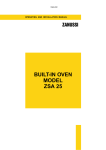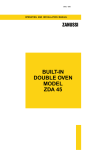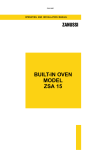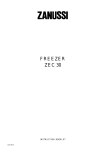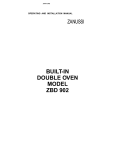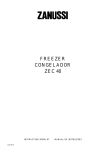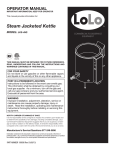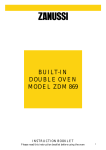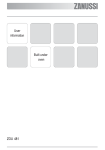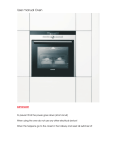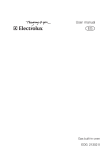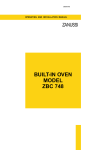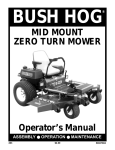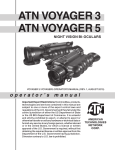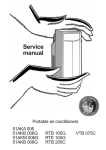Download Zanussi ZBS 701 Installation and Operation Manual
Transcript
35663 - 3302 OPERATING AND INSTALLATION MANUAL ZANUSSI BUILT-IN OVEN MODEL ZBS 701 2 WARNINGS AND GUIDANCE It is most important that this instruction book should be retained with the appliance for future reference. Should the appliance be sold or transferred, always ensure that the book is left with the appliance in order that the new owner can get to know the functions of the appliance and the relevant warnings. These warnings are provided in the interest of safety. You MUST read them carefully before installing or using the appliance. This oven is heavy and care must be taken when moving it. Ensure that all packaging, both inside and outside the oven, has been removed before the oven is used. The oven must be installed according to the instructions supplied. Any electrical work must be undertaken by a qualified electrician/competent person. It is dangerous to alter the specifications in any way. Always use oven gloves to remove and replace food in the oven. Similarly always use oven gloves to remove and replace the grill pan handle, before and after grilling. Ensure that you support the grill pan when removing it from the oven. Never line any part of the oven with aluminium foil. Do not allow heatproof cooking material, e.g. roasting bags, to come into contact with oven elements. After installation, please dispose of the packaging with due regard to safety and the environment. Always stand back from the oven when opening the oven door, to allow any build-up of steam or heat to release. During Operation Do not place sealed cans or aerosols inside the oven. They may explode if they are heated. Do not use this oven if it is in contact with water and never operate it with wet hands. Ensure that the anti-tip oven shelves are installed in the correct way (see instructions). This oven is designed to be operated by adults and children under supervision. Young children must not be allowed to tamper with the controls or play near or with the oven. CAUTION - accessible parts, especially around the grill area, may become hot when the oven is in use. Children should be kept away until it has cooled. Take great care when heating fats and oils as they will ignite if they become too hot. This oven has been designed for cooking edible foodstuffs only and must not be used for any other purposes. Never place plastic or any other material which may melt in or on the oven. Only clean this oven in accordance with the instructions. Take care to follow the recommendations given for tending the food when grilling. Use the handle provided in the recommended way. Do not hang towels or clothes from the oven or its handle. They are a safety hazard. After Use Ensure that all control knobs are in the OFF position when not in use. For hygiene and safety reasons, this oven should be kept clean at all times. A build-up of fats or other foodstuffs could result in a fire, especially in the grill pan. Always allow the cooling fan to cool the oven down before switching off at the electrical supply prior to carrying out any cleaning or maintenance work. Do not leave utensils containing foodstuffs, e.g. fat or oil in or on the cooker in case it is inadvertently switched ON. Ovens become very hot, and retain their heat for a long period of time after use. Children should be kept well away from the oven until it has cooled. Under no circumstances should you attempt to repair the appliance yourself. Repairs carried out by inexperienced persons may cause injury or serious malfunctioning. Refer to your local Zanussi Service Centre. Always insist on genuine Zanussi spare parts. Always grill with the oven door closed. Always remove the grill pan handles when grilling. Your safety is of paramount importance. Therefore, if you are unsure about any of the meanings of these WARNINGS, contact the Customer Care Department Customer Care Department Telephone: (01635) 521313 3 CONTENTS Warnings and Guidance Technical Data Installation and Electrical Connections Installation Electrical connection When the oven is first installed Use and Care How to set the programmer Controls Using the fan oven Grilling Thermal Grilling Helpful hints when buying and preparing food Cleaning the oven Care of catalytic liners Cleaning the Hinged Grill What Happens if something goes wrong Peace of mind for 24 Months This appliance complies with the following E.E.C. Directives: * 73/23 - 90/683 (Low Voltage Directive); * 93/68 (General Directives); * 89/336 (Electromagnetical Compatibility Directive) . and subsequent modifications MANUFACTURER: ELECTROLUX ZANUSSI ELETTRODOMESTICI S.p.A. Viale Bologna 298 47100 FORLÌ (Italy) WARNING Please remember that an appliance used for cooking does get hot, so make sure that children are kept well away while it is in use. Please complete and return the 24 months Guarantee card. In case of a complaint, and for ordering spare parts, you must specify the model number and serial number which appear on the rating plate situated on the cavity front panel. 4 Page 3 Page 5 Page 6 Page 7-8 Page 9 Page 10 Page 11 Page 12 Page 13 Page 14-15 Page 17 Page 17-18 Page 19 Page 20 Page 21 Page 22 Page 22 Page 23 TECHNICAL DATA Model Number: ZBS 701W - ZBS 701B Recess dimensions Height Width Depth Oven Capacity Internal oven dimensions Height Width Depth Oven Ratings Oven Element Grill Element Double Grill Element Convection Fan Oven Light Cooling fan Total Rating Cable (for UK use) Cable cross-section Type of cable Fuse (min.) Cable (for Europe use) Cable cross-section Type of cable Fuse (min.) 580 mm 560-570 mm 550 mm 1.9 cu. ft. 320 mm 420 mm 390 mm 2.5 kW 1.8 kW 2.8 kW 30 W 15 W 25 W 2.870 kW 6 mm 2 6242 Y 15 amp 2.5 mm2 Ho RR-F 13 amp 5 INSTALLATION AND ELECTRICAL CONNECTION FO 0701 WARNING Before installing the oven, ensure that the 4 plastic buffers are correctly fitted (as shown Fig. 1). These are supplied with the oven, and are in the bag with the guarantee card. We strongly recommend that all operations for the installation of your cooker be carryed out by QUALIFIED PERSONNEL in accordance with existing rules and regulations. Important Before the appliance is connected, check that the main fuse and the domestic installation can support the load; and that the power supply is properly earthed. The manufacturer disclaims any responsibility should these safety instructions not be carried out. FO 0702 6 Fig. 1 INSTALLATION It is mandatory that all operations required for the installation be carried out by a qualified or competent person - in accordance with existing rules and regulations. Please ensure that when the appliance is installed it is easily accessible for the engineer in the event of a breakdown. BUILDING IN It is important that the dimensions and materials of the surround or cabinet into which the oven will be built are correct and will withstand a temperature increase of at least 60°C above ambient; and that proper arrangements are made of a continuous supply of air to the oven so it does not overheat. FO 0374 Fig. 2 FO 0381 Fig. 3 Dimensions of the appliance and recess required are given below (Fig. 2-3). 7 Securing the oven to the cabinet Fit the appliance into the cabinet recess, open the oven door and unscrew the two upper screws of the door hinge (Fig. 4/a). Slightly slide forward the door in order to disengage it from the upper hinge (Fig. 4/b). Lift the oven door to disengage it from the lower hinge slipping off the pivot (Fig. 4/c). Secure the oven to the kitchen cabinet with four wood screws, which fit the holes provided in the oven frame (Fig. 4/d). Reassemble the oven door in reverse order. FO 0851 A A FO 1218 Fig. 4/a FO 0850 FO 0852 Fig. 4/b 8 Fig. 4/c Fig. 4/d ELECTRICAL CONNECTION We strongly recommend that all operations for the installation of your oven be carried out by QUALIFIED PERSONNEL to the relevant British Standards. The oven designed to be connected to 240V (50Hz) electricity supply. The oven has an easily accessible terminal block which is marked as follows: Letter L - Live terminal Letter N - Neutral terminal - Earth terminal Important After installation and connecting, the cable must be placed so that it cannot at any point reach a temperature of more than 50°C above the ambient temperature. Before the appliance is connected, check that the main fuse and the domestic installation can support the load; and that the power supply is properly earthed. The manufacturer disclaims any responsibility should these safety measures not be carried out. THIS APPLIANCE MUST BE EARTHED This appliance meets the requirements laid down in EEC Directive No. 89/336 relating to the suppression of radio and TV interference. The cable used to connect the oven to the electrical supply should have the characteristics indicated in the table. For Uk use only It is necessary that you install a double pole switch between the appliance and theelectricity supply (mains), with a minimum gap of 3mm between the switch contacts and of a type suitable for the required load in compliance with the current rules. Models Rating Cable cross section mm2 and Type of the cable ZBS 701 2870 W 6 mm2 6242 Y Fuse min. 15 A The switch must not break the yellow and green earth cable at any point. For Europe use only Models Rating ZBS 701 2870 W Cable cross section mm2 and Type of the cable 2,5 mm2 Ho5 RR-F Fuse min. 13 A 9 WHEN THE OVEN IS FIRST INSTALLED Once the oven has been installed, it is important to remove the protective materials which were put on in the factory. Press button E for manual function. Switch the oven control knob to fan ducted cooking and then set the thermostat control knob to MAX and leave it to run, empty, for 30 minutes to remove any unpleasant new smells. During this period, an unpleasant odour may be emitted, it is therefore, advisable to open a window for ventilation. Rating Plate The model number of your oven can be found on the rating plate on the lower front frame of the cooker upon opening the door. The oven must be protected by a suitably rated fuse or circuit breaker. The rating of the oven is given on the rating plate. About condensation and steam When food is heated it produces steam in the same way as a boiling kettle does. The oven is vented to allow some of this steam to escape. However, always stand back from the oven when opening the oven door to allow any build up of steam or heat to release. If the steam comes into contact with a cool surface on the outside of the oven, e.g. a trim, it will condense and produce water droplets. This is quite normal and is not caused by a fault on the oven. To prevent discolouration, regularly wipe away condensation and also soilage from surfaces. Cookware Baking trays, oven dishes, etc. should not be placed directly against the grid covering the fan at the back of the oven, or placed on the oven base. Do not use baking trays larger than 30 cm x 35 cm (12 in x 14 in) as they will restrict the circulation of heat and may affect performance. Advice on the effect of different materials and finishes of bakeware is given in 'Hints and Tips' in the appropriate oven section. 10 The trivet When roasting do use the trivet in the meat tin. Fat and meat juices will drain into the meat tin below and can be used to make gravy. The trivet also prevents splashes of fat from soiling the oven interior. N.B. The meat tin should not be placed on a heated hotplate as this may cause the enamel to crack. The cooling fan for the controls The cooling fan comes on immediately when the grill is switched on and after a short time when the oven is in use, and switches off when cooking is completed. During the initial period the cooling fan may cycle ON and OFF, this is quite normal. It may run on after the oven or grill is switched off to keep the controls cool. Always allow the cooling fan to cool the oven down before switching off the wall prior to carrying out any cleaning or maintenance work. NOTE The action of the cooling fan will depend on how long the oven or grill has been used and at what temperature. It may not switch in at all at lower temperature settings nor run on where the grill or oven has only been used for a short time. Control panel indicator neon This light indicates whether the oven or grill is switched ON. In the case of the oven, the neon also indicates when the set temperature has been reached. It will cycle on, and off during use to show that the temperature is being maintained. If the neon do not operate as the instructions indicate the controls have been incorrectly set. Return all controls to zero and reset following the instructions for the required setting. When the oven is set for automatic cooking the neon should remain unlit during OFF periods. USE AND CARE 1 2 TEMPERATURE FUNCTION 0 °C - + B U I LT- I N B U I LT- I N 3 5 6 7 8 4 1. 2. 3. 4. Electronic programmer Oven temperature light Oven function control knob Thermostat control knob 5. 6. 7. 8. Hinged grill element Interior light (oven light) Fan Grease filter 9. Removable handle (2) 10. Grill trivet 11. Grill / roasting pan 11 10 9 11 HOW TO SET THE PROGRAMMER CLOCK A KNOB - + B C D E MANUAL OPERATION TIMER COOKING TIME MANUAL OPERATION END OF COOKING SETTING THE TIME OF DAY 24 HOUR CLOCK SETTING THE AUTOMATIC TIMER - + - + - + To set oven for manual operation press button E. Press button B and C at the same time and while turning knob A enter the time of day. Press button C and while turning knob A enter the required cooking time. Then COOKING TIME SETTING THE TIMER - + - + - + Press button B and while turning knob A enter the required time (max. 23 h 59 min.). After required time has been selected the clock will revert to the time of day. When time is up an audible signal will be heard for approx 2 mins. To cancel press button B and return control and thermostat knobs to 'O' OFF. Press button C and while turning knob A enter the required cooking time. Auto will appear on the right hand side of the clock, select the required temperature and oven function. When cooking is completed an audible signal will be heard for approx 2 mins. To cancel press button B and return control and thermostat knobs to 'O' OFF. Press button D and while turning knob A enter the end of cooking time. Turn the thermostat and control function knobs to the required settings. The oven temperature light nor oven light will illuminate until the oven switches on. When cooking is completed the AUTO signal will flash and an audible signal will be heard for approx 2 mins. To cancel press button B and return control and thermostat knobs to 'O' OFF. To cancel any programme press button B 12 CONTROLS Push-Pull Control Knob The knobs of this oven are of the push-pull type. They can be completely sunken inside the control panel when the oven is not working (see Fig. 5). Oven Function Control Knob (fan) Oven light - this will come on automatically when the oven is in use. Defrost setting (NB This is NOT a cooking setting). This setting is intended to assist in thawing of frozen foods (see page 16). Conventional cooking, uses the top and bottom element; this function will enable you to use your favourite recipes without having to adapt the temperatures. It is necessary to pre-heat the oven in this instance. Top oven element only, enables you to finish off dishes on the top only. Bottom oven element only, enables you to finish off dishes on the bottom only. Fan ducted cooking - this allows you to roast or roast and bake simultaneously using any shelf, without flavour transference. Grill - the oven door MUST be closed when grilling. The grill cannot be used at the same time as the oven. Thermal grilling offers an alternative method of cooking food items normally associated with conventional grilling. The grill element and the oven fan operate together, circulating hot air around the food. Select a maximum temperature of 200° C Inner grill element only. Can be used for grilling one or two items. Note: When the control knob (Fig. 6) is on position ( ) light or ( ) defrost, the temperature control knob (Fig. 7) should by on the « » (Off) position. Caution Do not place pans, dripping pans, biscuit pans or aluminium foil directly on the base of the oven. This could cause a heat build-up which could affect the performance of the oven and damage the oven enamel. 0 FO 0350 Fig. 5 Fig. 6 FO 0777 100 MAX 0 150 FO 0776 20 By turning the oven control knob clockwise, you select the cooking temperature. Temperature selection starts at 50°C and is marked in 25°C increments up to maximum, where the temperature at the centre of the oven will reach approximately 250°C. The thermostat controlling the temperature is totally variable so it is possible to select temperatures between those marked. The MAX setting is particularly suitable for grilling. Once the oven temperature has been selected, the temperature light will come on and remain on until the oven has reached the correct setting; after that, it will go on and off with the thermostat, showing how the temperature is being maintained. 50 Thermostat Control Knob (Fig. 7) Fig. 7 13 USING THE CONVENTIONAL OVEN CONVENTIONAL COOKING This function uses the top and lower elements to give single level cooking. This is particularly suitable for disches which require extra base browning such as pizzas, quiches and flans. Gratins, lasagnes and hotpots which require extra top browning also cook well in the conventional oven. This form of cooking gives you the opportunity to cook without the fan in operation. For faster preheating use the fan oven function to preheat the oven until the oven indicator neon goes out, then swich the selector to the conventional oven setting. Single level cooking gives best results. If you require more than one level cooking use the fan or zoned oven functions. Top oven element only • Turn the function control knob to Conventional Oven . This function is suitable for finishing cooked dishes, eg; lasagne, shepherds pie, cauliflower cheese etc. • Turn the main oven temperature control to the required setting. Bottom oven element only NOTE: a) The selector and oven temperature indicator windows will illuminate. b) The oven indicator neon will glow. THINGS TO NOTE The oven indicator neon will glow until the oven has reached the desired temperature and then go OUT. It will then cycle ON and OFF showing that the oven temperature is being maintained. The internal oven light operate when the selector is set. If an automatic programme is set, the oven light will come on when the cook time starts. The control cooling fan will operate after a short time and runs on after the controls are swiched off until the appliance has cooled. HINTS AND TIPS The middle shelf position allows for the best heat distribution. To increase base browning simply lower the shelf position. To increase top browning, raise the shelf position. The material and finish of the baking traus and dishes used will affect base browning. Enamelware, dark, heavy or non-stick utensils increase base browning, while oven glassware, shiny aluminium or polished steel trays reflect the heat away and given less base browning. Always place dishes centrally on the shelf to ensure even browning. Stand dishes on suitably sized baking trays to prevent spillage onto the base of the oven and make cleaning easier. Do not place dishes, tins or baking trays directly on the oven base as it becomes very hot and damage will occur. 14 This function is particularly useful when blind-baking pastry or cooking pizza. USING THE FAN OVEN The Fan Oven HINTS AND TIPS The air inside the oven is heated by the element around the fan situated behind the back panel. The fan draws air from the oven, the element heats the air which is circulated into the oven via the top, base and sides of the back panel. The advantages of cooking with this function are: Runner positions are not critical, but make sure the shelves are evenly spread. Faster Preheating Because the fan oven quickly reaches temperature, it is not usually necessary to preheat the oven although you may find that you need to allow an extra 5-7 minutes on cooking times. For recipes which require higher temperatures, best results are achieved if the oven is preheated first, e.g. bread, pastries, scones, souffles, etc. Lower Temperatures Fan oven cooking generally requires lower temperatures than conventional cooking. Follow the temperatures recommended in the charts or remember to reduce temperatures by about 2025°C for your own recipes which use conventional cooking. Even Heating for Baking The fan oven has uniform heating on all runner positions. This means that batches of the same food can be cooked in the oven at the same time. However, the top shelf may brown slightly quicker that the lower one. This is quite usual. There is no mixing of flavours between dishes (see Fig. 9). When cooking more than one dish in the fan oven, place dishes centrally on the shelves rather than several dishes on one shelf. When the oven is full, you may need to allow slightly longer cooking time. A shelf may be placed on the floor of the oven. Place dishes on a shelf in this position rather than on the oven base, to allow air circulation around the food. When the oven is full of the same food, e.g. equal trays of small cakes or equal size victoria sandwich cakes, then they will be cooked in the same time and removed from the oven together. When different sizes of trays or types of food, e.g. biscuits and cakes are cooked, they will not necessarily be ready together. The fan oven can be used to heat foods through without thawing first, e.g. fruit tarts, mince pies, sausage rolls, and other small pastry items. Use a temperature of 190-200°C and allow 20-40 minutes (depending on the quantity of food in the oven). The use of too high temperatures can cause uneven browning. Check with the recommendations for oven temperatures given in the cooking charts, but be prepared to adjust the temperature by 10°C if necessary. Remember to reduce temperatures by about 20-25°C for your own conventional recipes. The oven is supplied with two anti-tip shelves. IMPORTANT: The anti-tip oven shelves must be positoned as shown in Fig. 8. 4 3 2 1 FO 0285 Fig. 8 FO 0061 Fig. 9 15 Only experience will enable you to determine the proper settings for your personal cooking needs. The temperatures are intended as a guide only. It may be necessary to increase or decrease the temperature to suit your individual requirements. The effects of dishes on cooking results Dishes and tins vary in their thickness, conductivity, colour, etc. which affects the way they transmit heat to the food inside them: A Aluminium, earthenware, oven glassware and bright shiny utensils reduce cooking and underneath browning. B Enamelled cast iron, anodized aluminium, aluminium with non-stick interior and coloured exterior and dark, heavy utensils increase cooking and underneath browning. Defrosting The defrosting function allows you to defrost frozen foods. The oven fan operates without heat and circulates the air, at room temperature, inside the oven. This increases the rate at which defrosting takes place. This function is particularly suitable for delicate food which could be damaged by heat, e.g. cream filled gateaux, iced cakes, pastries, bread and other yeast products. HINTS AND TIPS • Cover food with a lid, aluminium foil or plastic film to prevent drying out during defrosting. • Small or thin pieces of fish fillet or peeled prawns, mince, liver and thin chops will defrost in 1-2 hours. Ensure that they are cooked or refrigerated immediately after defrosting to maintain good food hygiene. • Place the food to be defrosted in a single layer and turn over half way through the defrosting process, where possible. • Joints of meat or poultry MUST BE THAWED THOROUGHLY BEFORE COOKING. A 1.5 kg/3lb oven-ready chicken will thaw in approximately 5 hours. The giblets must be removed as soon as possible during the thawing process. • Only joints of meat and poultry up to 2kg/4lb in weight are suitable for defrosting in this way. ALWAYS COOK THOROUGHLY IMMEDIATELY AFTER THAWING. • Take care to follow the basic rules for hygiene when handling fresh, frozen, raw and cooked foods. 16 HINTS AND TIPS • Place the frozen food a single layer where possible, and turn it over half way through the defrosting process. • The actual speed of defrosting is influenced by room temperature. On warm days defrosting will be faster than on cooler days. • DO NOT leave food at room temperature once it is defrosted. Cook raw food immediately or store cooked food in the fridge. • Care must always be taken when handling foods in the home. Always follow the basic rules of food hygiene to prevent bacterial growth and cross contamination when defrosting, preparing, cooking, cooling and freezing foods. GRILLING GRILLING - INNER GRILL ELEMENT Important All grilling must be carried out with the oven door closed and the grill pan handle removed from the pan. Important All grilling must be carried out with the oven door closed and the grill pan handle removed from the pan. Most foods should be placed on the grid in the grill pan to allow maximum circulation of air to lift the food out of the fats and juices. Food such as fish, liver and kidneys may be placed directly on the grill pan, if preferred The inner grill provides, quick direct heat to the central area of the grill pan. By using the inner grill for cooking small quantities it can help to save energy. Adjust the grid and grill pan runner position to allow for different thicknesses of food. Position the food close to the element for faster cooking and further away for more gentle cooking Food should be thoroughly dried before grilling to minimise splashing. Brush lean meats and fish lightly with a little oil or melted butter to keep them moist during cooking Accompaniments such as tomatoes and mushrooms may be placed underneath the grid when grilling meats When toasting bread, we suggest that the top runner position is used with the grid in its 'high' position Preheat the grill on a full setting for a few minutes before sealing steaks or toasting. Adjust the heat setting and the shelf as necessary, during cooking The food should be turned over during cooking, as required. NOTE: For safety in use, the grill element is controlled by the thermostat. During cooking, the grill cycles on and off to prevent overheating. COOKING GUIDE Cooking time depends on the thickness of the meat and not on its weight. Always grill with the door closed and remove the grill pan handle. Place the food in the centre of of the grid in the grill pan. Adjust the gril and grill pan runner position to allow for different thicknesses of food and follow the instructions for grilling. THERMAL GRILLING Use of thermal grilling Thermal grilling offers an alternative method of cooking food items normally associated with conventional grilling. The grill element and the oven fan operate alternately, circulating hot air around the food. The need to check and turn food is reduced. Thermal grilling helps to minimise cooking smells in the kitchen and allows you to grill with the oven door closed. With the exception of toast and rare steaks, you can thermal grill all the foods you would normally cook under a conventional grill. The lower part of the oven can be used to cook accompaniments at the same time, e.g. tomatoes and mushrooms with a mixed grill or breakfast. Dishes prepared in advance such as shepherd's pie, lasagne and au gratins can be heated through and browned on the top using the thermal grilling function. • Turn the multifunction selector to Thermal Grill . • Turn the main oven temperature control to the required setting (A temperature of between 140°C and 200°C is suitable for thermal grilling). NOTE: Thermal grilling helps to minimise cooking smells in the kitchen and is carried out with the main oven door closed, and with the grill pan handle removed. THINGS TO NOTE The oven indicator neon will glow until the oven has reached the desired temperature and then go OFF. It will then cycle ON and OFF showing that the oven temperature is being maintained. 17 The indicator windows for selector and oven temperature control will illuminate. selected. Be prepared to adjust temperature and shelf positions during cooking, if necessary. The oven fan and internal oven light will come on. Turn food over during cooking, as necessary. The control cooling fan will operate after a short time. It will run on after the controls are switched off until the appliance has cooled. Ensure that ready prepared or cooked chilled dishes, e.g. shepherds pie, moussaka, lasagne, etc., are piping hot throughout before serving. HINTS AND TIPS A temperature range of 140-220°c and shelf positions 3 and 4 are suitable for most foods. Be prepared to make adjustments during cooking to suit individual requirements. If thermal grilling on more than one level, it may be necessary to interchange the food on the shelves during cooking. Prepare foods in the same way as for conventional grilling. Brush lean meats and fish lightly with a little oil or butter to keep them moist during cooking. Most foods should be placed on the grill pan grid in the 'high' position in the grill pan to allow maximum circulation of air around the food. Food such as fish, liver and kidneys may be placed directly onto the trivet in the grill pan, if preferred. The use of the trivet beneath the grid when grilling fatty foods will help minimise splashing. Accompaniments such as tomatoes and mushrooms may be placed below the grid when grilling meat, or in a separate dish on a lower shelf. COOKING TIMES Cooking is more gentle, therefore food generally takes a little longer to cook with thermal grilling compared with conventional grilling. One of the advantages is that larger loads can be cooked at the same time. A general guide to cooking times is given below but these times may vary slightly depending on the thickness and quantity of food being cooked. Foods will cook more quickly the closer they are to the grill element and the higher the temperatures FOOD Bacon Rashers Beefburgers Chicken Joints Chops - Lamb - Pork Fish - Whole Trout/Herring - Fillets Plaice/Cod Kebabs Kidneys - Lamb/Pig Liver - Lamb/Pig Sausages Toast Heating through and Browning, e.g. au-gratin, lasagne, shepherd's pie. Browning dishes only Grill and Economy Grill Thermal Grill Temp (°C) Time (Mins per side) Temp (°C) Time (Mins) 210 200 170 180 180 170 170 180 170 170 180 250 2-3 6-10 10-15 7-10 10-15 8-12 4-6 10-15 4-6 5-10 10-15 1-2 200 190 160 170 170 170 170 170 180 180 190 - 8-12 10-15 35-45 20-25 25-35 10-20 10-20 20-30 10-15 20-30 10-15 - - - 230 3-5 170 depending on size - 20-30 depending on size - The times quoted above are given as a guide and should be adjusted to suit personal taste. 18 HELPFUL HINTS WHEN BUYING AND PREPARING FOOD Care must be taken when handling foods in the home. Always follow the basic rules of food hygiene to prevent bacterial and microbial growth and cross contamination when preparing, reheating, cooking, cooling, defrosting and freezing foods: 1. Always ensure food you purchase is of good quality and in prime condition. Shop at a reliable source and buy the 'freshest' looking package avoid shopworn labels or produce covered in dust. 2. Avoid buying chilled or frozen products if you cannot store them straight away. The use of an insulated container when shopping is advisable. 3. Buy and consume foods prior to the 'Sell by' or 'Best Before' date. 4. When you arrive home, place perishable foods in the refrigerator or freezer immediately. Ensure they are well covered to prevent them drying out and to prevent any possible cross contamination with bacteria from raw to cooked foods. 5. Follow the cooking instructions on packets of prepacked and cook chill foods, but be prepared to adjust cooking time and temperatures to suit your particular oven. For example, the fan oven generally requires 20-25°C lower temperature than conventional ovens. 10. Cook meat thoroughly - use a meat thermometer if preferred, which penetrates the joint to check that the centre temperature has reached the required temperature (see table below). MEAT TEMPERATURES Beef Rare - 60°C Medium - 70°C Well Done - 80°C Pork Well Done - 80°C Lamb Medium - 70°C Well Done - 80°C 11. If not eaten straightaway after cooking, food should be cooled as quickly as possible (within one hour) and then refrigerated or frozen as required. (Do not put hot food into a Refrigerator or Freezer). 12. In the kitchen keep work tops, chopping boards and utensils clean with hot soapy water between preparation stages. Ideally, keep one chopping board for raw meat and another for other foods. Keep your dish cloths and tea towels clean. 6. Always ensure that cook chill foods are thoroughly re-heated until they are piping hot throughout. 7. It is preferable to defrost frozen foods slowly in the refrigerator. Alternatively, a microwave cooker or the defrost function on your oven may be used. 8. Always cook defrosted foods immediately after thawing. Thawed food should never be refrozen. 9. Joints of meat and poultry should be thoroughly defrosted before cooking. 19 CLEANING THE OVEN Before cleaning always allow the cooling fan to cool the oven down before switching off at the electricity supply Replacing Components Prior to undertaking any maintenance work or replacing the oven light, be sure to disconnect appliance from the electricity supply. Cleaning materials Before using any cleaning materials on your oven, check that they are suitable and that their use is recommended by the manufacturer. Cleaners that contain bleach should NOT be used as they may dull the surface finishes. Harsh abrasives should also be avoided. Replacing the Oven Light Push in and turn the glass cover anticlockwise (Fig. 11). Remove the faulty bulb and replace with one which is heat resistant to 300°C. Glass Panel This should be cleaned with a soft cloth soaked in warm soapy water. Do not use abrasive scourers or steel wool. Oven Shelves To clean the oven shelves, soak in warm soapy water and remove stubborn marks with a well wetted soap impregnated pad. Rinse well and dry with a soft cloth. Oven Cavity The enamelled oven cavity is best cleaned whilst the oven is still warm. It is advisable to wipe the oven over with a soft cloth soaked in warm soapy water after each use. However, from time to time it will be necessary to do a more thorough cleaning, using a proprietary oven cleaner. Grease Filter When cooking meat the grease filter must be fitted over the upper oven fan by clipping it over the vents in the back panel, this will prevent a built-up of fat on the fan impellor. Do not use abrasive materials to clean the seal. The grease filter is dishwasher proof. When cooking is completed and the oven has cooled down, remove the filter as instructed below and wash carefully. - Push the protruding tongue on the filter, upward (See Fig. 10) FO 0018 20 Fig. 10 FO 0287 Fig. 11 Electric bulb: 15W, 220-240 V, 50 Hz, 300°C, E14. These bulbs are available from your local Zanussi Service Centre whose address can be found in the Zanussi Customer Care Booklet. CARE OF CATALYTIC LINERS Catalytic liners destroy splashes of food and fats when the oven temperature is raised to around 220°C. To aid this process it is a good idea to run the oven for an hour or two per week, without food, to ensure continued good performance from the Catalytic liners. Hints and tips • Manual cleaning of the Catalytic liner is not recommended. Damage will occur if soap impregnated steel wool pads, aerosol cleaners and any other abrasives are used. • Slight discolouration and polishing of the Catalytic surface may occur in time. This does not affect the Catalytic properties in any way. • Follow the recommendations below to keep oven soilage to a minimum. Cooking to reduce soilage Cook at the recommended temperatures. Higher temperatures during roasting will increase soilage. Try cooking to lower temperatures for an increased length of time, you will save energy and often the joint is more tender. Use minimal, if any, extra oil or fat when roasting meat; potatoes only require brushing with fat before cooking. Extra fat in the oven during roasting will increase splashing and soilage. It is NOT necessary to add water to the meat tin when roasting. The water and the fat juices from the joint create excessive splattering during cooking, even at normal temperatures, as well as causing condensation. Covering joints during cooking will also prevent splashing onto the interior surfaces; removing the covering for the last 20-30 minutes will allow extra browning, if required. Some large joints and turkeys especially benefit by this method of cooking, allowing the joint to cook through before the outside is overbrowned. Do use the trivet in the roasting tin. During roasting, the fat from the joint will be contained beneath the trivet and therefore prevent it from splattering onto the 'Catalytic' liner. 21 CLEANING THE HINGED GRILL This model has been fitted with a hinged top grill element to enable you to clean the roof of the oven easily. Then gently pull the grill downward to allow access to the oven roof. (see Fig. 13) Before proceeding ensure the oven is isolated from the electricity supply. Then undo the screw which holds the grill in place. (see Fig. 12) FO 0778 FO 0781 Fig. 12 Fig. 13 Clean the oven roof with a suitable clener and wipe dry before replacing the hinged grill element. Gently push up the grill element into place and firmly screw into place the holding nut. NOTE: Ensure the grill holding nut is firmly in place to avoid the grill falling down during operation. WHAT HAPPENS IF SOMETHING GOES WRONG If the oven does not come on: * Check the oven is in manual operation * Check that it is plugged in properly * Check that the socket switch and/or the switch from the mains supply to the oven are ON * Replace the fuse in the plug, if required, with another of the same rating and check that this plug has been wired up correctly * Check that the socket, when present, is receiving power - by plugging in an appliance you know to be working * Check that the fuse in the fuse box is intact In after all these checks, the oven still does not work, contact your local Zanussi Service Centre quoting your model and serial number. 22 Please note that it will be necessary to provide proof of purchase for any inguarantee service calls. In-guarantee customers should ensure that the above checks have been made as the engineer will make a charge if the fault is not a mechanical or electrical breakdown. CUSTOMER CARE DEPARTMENT For general enquiries concerning your Zanussi appliance, contact our Customer Relations Department by letter or telephone as follows: Customer Care Department Zanussi House Hambridge Rd. Newbury Berks RG14 5EP Tel: 01635 - 521313 PEACE OF MIND FOR 24 MONTHS ZANUSSI GUARANTEE CONDITIONS EXCLUSIONS This guarantee is in addition to your statutory and other legal rights. This guarantee does not cover: We, Zanussi Ltd., undertake that, if, within twenty four months of the date of the purchase, this ZANUSSI appliance or any part thereof is proved to be defective by reason only of faulty workmanship or materials, we will, at our option, repair or replace the same FREE OF ANY CHARGE for labour, materials or carriage on condition that: * The appliance has been correctly installed and used on the electricity supply stated on the rating plate. * The appliance has been used for normal domestic purposes only, and in accordance with the manufacturer's operating and maintenance instructions. * The appliance has not been serviced, maintained, repaired, taken apart or tampered with by any person not authorised by us. All service work under this guarantee must be undertaken by a Zanussi Service Centre. Home visits are made between 8.30 am and 5.30 pm Monday to Friday. Visits may be available outside these hours in which case a premium will be charged. Any appliance or defective part replaced shall become our property. * Damage or calls resulting from transportation, improper use or neglect, the replacement of any light bulbs or removable parts of glass or plastic. * Costs incurred for calls to put right machines improperly installed or calls to machines outside the UK and the Republic of Ireland. * Appliances found to be in use within a commercial or similar environment, plus those which are subject to rental agreements. * Products of Zanussi manufacture which are NOT marketed by Zanussi Ltd. * EU Countries - The standard guarantee is applicable but subject to the owner's responsibility and cost to ensure the appliance meets the standards set by the country to which the product is taken. The Zanussi Company in the country concerned will be pleased to advise further. Sight of your purchase receipt will be required by them. 23






















